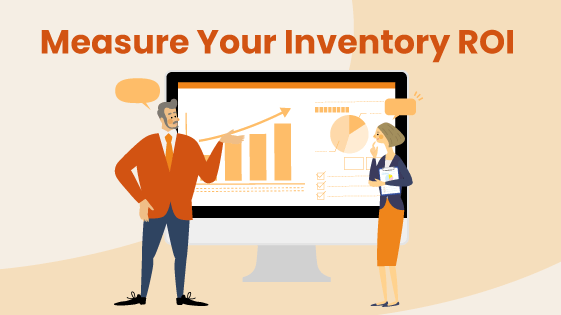In an ideal world, you have exactly the right amount of each product in your store at any given time. There are no surpluses so you can maximize your inventory storage spaces, and no shortages so you can maximize your sales and return on your investment (ROI). Unfortunately, this will never happen. But that doesn’t mean you should stop trying! Managing your ordering and inventory must be a constant battle for all retailers.
The best way to improve is to look at the data and analytics from your POS system. These will break down the info into helpful metrics to measure your retail inventory ROI. But what are the best inventory metrics to track? And how can they help your small business inventory management? Here is our list of the top 5 that every business owner should keep an eye on!

1. GMROI
Standing for gross margin return on investment, this will show you how much money you got back for every dollar that you invested in your inventory. It’s a simple calculation – all you need is the amount of money you spent on your stock and the amount of money you made in sales. Divide your margin by the average inventory cost of a given period of time.
For example, if you spend $500 on inventory and made $1000, your GMROI would be 2.0. If you made $750, it would 1.5. A GMROI of 1 is another way of saying breaking even.
Advanced inventory tools with your retail point of sale software can calculate this automatically and in more detail. A good understanding of your GMROI will help you decide which products are worth keeping around and which are worth discontinuing. And it will give you a chance to adjust pricing or look for cheaper suppliers if your GMROI is too low.
2. Sell-Through Rate
Sell-through rate calculates the number of your products that were sold versus those that were on-hand to be sold. Like all of these, it’s remarkably simple to calculate: Divide the number sold by the number in your initial inventory and multiply the result by 100 again to get the percentage.
If you own a liquor store and bought 100 cases of a big, juicy Lodi Zinfandel and sold 70 cases, your sell-through rate is, of course, 70%.
It’s important to determine a time frame for your sell-through rate goals. Eventually, all sell-through rates would get to 100%, but you can’t afford that to take 5 years. You want to optimize the speed at which your inventory leaves the store so that you can take advantage of your limited inventory space and maximize your profits. Try comparing sell-through rates for certain at different intervals of time to see if and how it might change.
Sell-through rates can help you determine which products you need to order more frequently and which could use a little boost through a promotion or targeted ad.
3. Best and Worst Performers
This is less concrete than the first four and requires more advanced retail inventory management systems. Doing so will give you a better idea of what items need a little help and which you made need to order more frequently.
Tools like KORONA POS’s ABC analysis for retail are invaluable to small business owners looking to measure retail inventory ROI. Following the basic tenets of the 80/20 rule (20% of your products account for 80% of your revenue), this software automatically categorizes every product on your shelves into either A, B, or C.
Generally, you want to pay the most attention to the A and C products. The “A” can be highlighted and pushed to the best shelf space available in your store. They drive sales and revenue; therefore, you cannot afford to ever be out of stock. You might also consider lost sales with your top sellers. If you’ve run out of their inventory at any time, calculate how much in potential sales were lost by multiplying the number of days it was out of stock and the average number sold per day. This will incentivize you to avoid stockouts on your best products absolutely.
The “C” items, on the other hand, might need to be tweaked in some way and then featured in a promotion or sale.
“B’ products are your middle-of-the-road stock. They bring in some revenue but aren’t as integral to your business’s success. These are great for A/B testing on slight product changes. Choose a few “B” products to try out some changes and see how they impact sales. Positive results can then be applied to other items.
Ray Li, a founder of the LA-based custom apparel retailer, Sene, points out a great benefit of A/B testing:
“From an analytics standpoint, we need to understand what styles perform so that we can keep iterating on variations of those styles to create variety for our customers. For example, we were testing lower price points and higher price points and using the data from the POS system to help us understand what styles to optimize for and what styles to retire.”
4. Shrinkage
In the retail world, shrinkage refers to any discrepancy between what your inventory records indicate and what inventory you actually have on hand. In other words, it measures any missing stock. Below are the most common causes of retail shrinkage in order of occurrence, according to the National Retail Federation:
- Shoplifting (~38%)
- Internal Theft (~34.5%)
- Clerical Errors (a great inventory management system helps with this!) (~16%)
- Vendor Mistakes/Fraud (~7%)
- Unknown Causes (6%)
To calculate your business’s shrinkage, divide the total dollar value of shrinkage and divide it by total sales. Multiple the result by 100 to express it as a percentage.
The average shrinkage rate across U.S. retail hovers around 2%. That sounds low, but 2% of all annual retail sales is a casual $50 billion.
The rates of shrinkage vary across different retail sectors. A convenience store, for instance, is prone to higher rates of shrinkage than a gift shop.
There are various measures retailers can take to minimize shrinkage, from employee bag checks and warning signs to POS security settings and security chipped products. Check out our blog on retail theft prevention tips.

5. Inventory Turnover Rate
Similar to the sell-through rate, inventory turnover is a way of measuring how fast a product is moving off your shelves. Typically, a high turnover rate is a great problem to have. It might mean adjusting your ordering, but it’s a sign of great efficiency.
A low turnover rate, on the other hand, indicates low sales volume, so you might need to examine factors such as demand, advertising, pricing, and quality as possible explanations.
To figure out your stock turn, take your costs of products sold and divide by the average inventory cost.
You can adjust your calculations using different time constraints. If your business is seasonal you’ll want to measure your turnover rates more frequently, while retailers with more consistent sales can just calculate it annually.
Another way of approaching this metric is to determine the average number of days it takes to sell a certain item in your inventory. It’s a simple way to prevent both out of stock and dead-stock items.
How Will You Measure Retail Inventory ROI at Your Small Business?
Using these 5 inventory metrics alongside understanding trade spend in retail can be critical to the success of your business. It’s impossible to keep track of it all in your head, so make sure you have the best retail inventory management software to help you out.
KORONA POS has been a huge game changer for my overall profitability. Implementation was seamless and painless! The support staff is great and always ready to help. Had I known it would be this easy, I would have made the switch sooner!
-Kristen L.
Check out KORONA POS and schedule a free demo so you can see firsthand just how helpful detailed inventory reporting and analysis can be for all retailers. Just click below to find out more!













